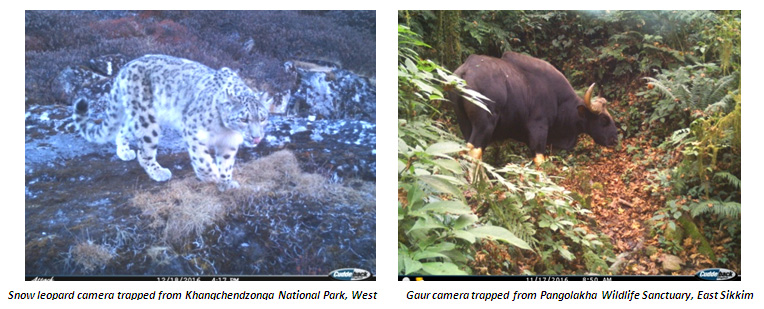
August 12, 2017: As a part of scientific monitoring of major wildlife species, a State level assessment of wildlife populations for all eight Protected Areas of Sikkim was conducted for the first time by the Department of Forests, Environment & Wildlife Management, Government of Sikkim with the technical support and guidance from the Wildlife Institute of India, Dehradun.
The main objective was to estimate the density of large and medium sized carnivores, their prey base and the habitat distribution. This exercise has given a fair assessment of the status of wildlife richness and population status in the State which will be useful to plan wildlife management in the protected areas and set a benchmark for future similar studies and research.The four month long exercise involving modern wildlife surveying techniques such as camera trapping of images was funded within the JICA assisted Sikkim Biodiversity Conservation & Forest Management Project.
The entire exercise was undertaken in the post- monsoon and winter months when spotting of wildlife is easier. Protected area wise survey teams involving field staffs, Eco-Development Committees, Joint Forest Management Committees, local NGOs were set up to install cameras along carefully identified transects, considering potential habitats in all Protected Areas. A total of 262 camera traps were installed out of which 37 species were captured from 189 locations, with some significant findings such as gaur, marble cat, three morphs of golden cat and melanistic morph of common leopard.
As per the camera trap photos of snow leopards from the Khangchendzonga National Park (western part) above 4000m it was inferred that at least 4-5 snow leopard individuals were present during the survey in western part of Khangchendzonga NP. These findings are comparable with the findings of an abundance estimation study carried out in the same region in 2011 by Wildlife Institute of India, where presence of four individuals was mentioned (Sathyakumar et. al. 2014).
In Sikkim, potential snow leopard habitat is estimated as 2845 km2 (Bhatnagar et al. 2016), out of which, 816 km2 can be classified as “good habitat” and rest 2029 km2 can be classified as “poor habitat”. Extrapolation of the density estimates of 4.25 snow leopard/100 km2 (Sathyakumar et al. 2014) for “good habitats” and 0.21/ 100 km2 (Bhatnagar et al. 2016) for “poor habitats” indicates the presence of about 39 snow leopard individuals in the entire State of Sikkim which shows increase in the number of snow leopard in comparison to earlier studies and research. The population estimation of Red panda, the State animal, is 378 in the protected areas.
In the next phase the exercise is proposed to be carried out in the reserved forest areas falling outside protected areas as well as in the PAs to get a more complete picture of wildlife populations in the State.
Source: Wildlife Division, Forests, Environment and Wildlife Management Department, Government of Sikkim